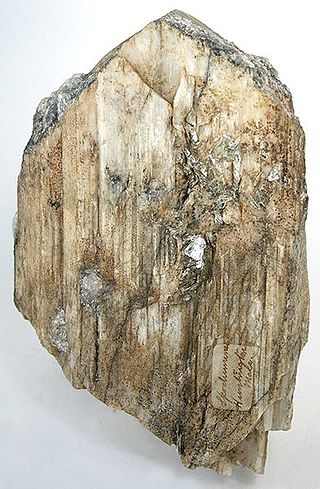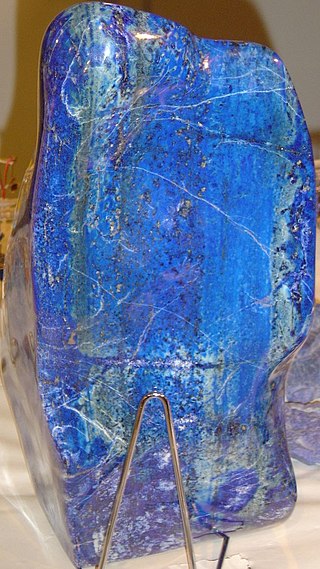
Lithium is a chemical element with the symbol Li and atomic number 3. It is a soft, silvery-white alkali metal. Under standard conditions, it is the least dense metal and the least dense solid element. Like all alkali metals, lithium is highly reactive and flammable, and must be stored in vacuum, inert atmosphere, or inert liquid such as purified kerosene or mineral oil. It exhibits a metallic luster. It corrodes quickly in air to a dull silvery gray, then black tarnish. It does not occur freely in nature, but occurs mainly as pegmatitic minerals, which were once the main source of lithium. Due to its solubility as an ion, it is present in ocean water and is commonly obtained from brines. Lithium metal is isolated electrolytically from a mixture of lithium chloride and potassium chloride.

Spodumene is a pyroxene mineral consisting of lithium aluminium inosilicate, LiAl(SiO3)2, and is a commercially important source of lithium. It occurs as colorless to yellowish, purplish, or lilac kunzite (see below), yellowish-green or emerald-green hiddenite, prismatic crystals, often of great size. Single crystals of 14.3 m (47 ft) in size are reported from the Black Hills of South Dakota, United States.

Rio Tinto Group is a British-Australian multinational company that is the world's second-largest metals and mining corporation. It was founded in 1873 when a group of investors purchased a mine complex on the Rio Tinto, in Huelva, Spain, from the Spanish government. It has grown through a long series of mergers and acquisitions. Although primarily focused on extraction of minerals, it also has significant operations in refining, particularly the refining of bauxite and iron ore. It has joint head offices in London, England and Melbourne, Australia.
Eastnor is a village in Bubi District, Matabeleland North, Zimbabwe and is located about 125 km northeast of Bulawayo in a commercial farming and gold mining area. It lies next to the Umguemembe, and is within the Bubi Mining District. The mining EPOs/leases were owned by Duration Gold in the south, BilboesGold in the north and Metallon Group in the center. Motapa Mine is immediately adjacent to the village, to the northeast. Bilboes Mine and Motapa Mine were sold to Caledonia Mining Corporation in 2022.

NMDC Limited, formerly National Mineral Development Corporation, is an Indian public sector undertaking involved in the exploration of iron ore, copper, rock phosphate, limestone, dolomite, gypsum, bentonite, magnesite, diamond, tin, tungsten, graphite, coal etc. It is India's largest iron ore producer and exporter, producing more than 35 million tonnes of iron ore from three mechanized mines in Chhattisgarh and Karnataka. It also operates the only mechanized diamond mine in the country at Panna in Madhya Pradesh.

Mining in Australia has long been a significant primary sector industry and contributor to the Australian economy by providing export income, royalty payments and employment. Historically, mining booms have also encouraged population growth via immigration to Australia, particularly the gold rushes of the 1850s. Many different ores, gems and minerals have been mined in the past and a wide variety are still mined throughout the country.

Mining in Western Australia, together with the petroleum industry in the state, accounted for 94% of the State's and 46% of Australia's income from total merchandise exports in 2019–20. The state of Western Australia hosted 123 predominantly higher value and export-oriented mining projects and hundreds of smaller quarries and mines. The principal projects produced more than 99 per cent of the industry's total sales value.
Kamativi is a small mining town in Matabeleland North province, Zimbabwe. The Kamativi tin mine is located next to the town, is the reason for the town's extistance, and gave the town its name. The name Kamativi is derived from the word "mativi" which means "sides", "embankments" or "valleys", with the diminutive prefix "ka" - though not grammatically correct - makes the name "little valleys".

Fortescue is a global green energy company headquartered in Australia. Fortescue was originally focused on iron ore mining under the name of Fortescue Metals Group until July 2023. As of 2017, Fortescue is the fourth-largest iron ore producer in the world. The company has holdings of more than 87,000 km2 in the Pilbara region of Western Australia, making it the largest tenement holder in the state, larger than both BHP and Rio Tinto.

Mining in Afghanistan was controlled by the Ministry of Mines and Petroleum, prior to the August 15th takeover by the Taliban. It is headquartered in Kabul with regional offices in other parts of the country. Afghanistan has over 1,400 mineral fields, containing barite, chromite, coal, copper, gold, iron ore, lead, natural gas, petroleum, precious and semi-precious stones, salt, sulfur, lithium, talc, and zinc, among many other minerals. Gemstones include high-quality emeralds, lapis lazuli, red garnet and ruby. According to a joint study by The Pentagon and the United States Geological Survey, Afghanistan has an estimated US$1 trillion of untapped minerals.
Resources are classified as either biotic or abiotic on the basis of their origin. India contains a multitude of both types of resource and its economy, especially in rural areas, is heavily dependent on their consumption or export. Due to overconsumption, they are rapidly being depleted.

Manono is a town and territory in Tanganyika Province, Democratic Republic of the Congo.

The geology of Zimbabwe in southern Africa is centered on the Zimbabwe Craton, a core of Archean basement composed in the main of granitoids, schist and gneisses. It also incorporates greenstone belts comprising mafic, ultramafic and felsic volcanics which are associated with epiclastic sediments and iron formations. The craton is overlain in the north, northwest and east by Proterozoic and Phanerozoic sedimentary basins whilst to the northwest are the rocks of the Magondi Supergroup. Northwards is the Zambezi Belt and to the east the Mozambique Belt. South of the Zimbabwe Craton is the Kaapvaal Craton separated from it by the Limpopo Mobile Belt, a zone of deformation and metamorphism reflecting geological events from Archean to Mesoproterozoic times. The Zimbabwe Craton is intruded by an elongate ultramafic/mafic igneous complex known as the Great Dyke which runs for more than 500 km along a SSW/NNE oriented graben. It consists of peridotites, pyroxenites, norites and bands of chromitite.
Mining in North Korea is important to the country's economy. North Korea is naturally abundant in metals such as magnesite, zinc, tungsten, and iron; with magnesite resources of 6 billion tonnes, particularly in the North and South Hamgyong Province and Chagang Province. However, often these cannot be mined due to the acute shortage of electricity in the country, as well as the lack of proper tools to mine these materials and an antiquated industrial base. Coal, iron ore, limestone, and magnesite deposits are larger than other mineral commodities. Mining joint ventures with other countries include China, Canada, Egypt, and South Korea.

The Greenbushes lithium mine is an open-pit mining operation which is in Western Australia and is the world's largest hard-rock lithium mine. It is located to the south of the town of Greenbushes, Western Australia. The Greenbushes lithium mine produces approximately 1.95 million tonnes of lithium spodumene annually. The mine is 250 kilometres (160 mi) south of Perth and 90 kilometres (56 mi) southeast of the Port of Bunbury.
The Bikita mine is the largest lithium mine in Zimbabwe. The privately owned company holds the world’s largest-known deposit of lithium at approximately 11 million tonnes. The mine is located in southern Zimbabwe in Masvingo Province. The Bikita mine has reserves amounting to 10.8 million tonnes of lithium ore grading 1.4% lithium thus resulting 0.15 million tonnes of lithium.
The Manono-Kitolo mine is a former tin and coltan mine, which also contains one of the largest lithium reserves globally, in the Democratic Republic of the Congo. The mine is located in southern Democratic Republic of the Congo in Tanganyika Province. The Manono-Kitolo mine has reserves amounting to 120 million tonnes of lithium ore grading 0.6% lithium thus resulting 0.72 million tonnes of lithium.

Australia has one of the biggest lithium reserves and is the biggest producer of lithium by weight, with most of its production coming from mines in Western Australia. Most Australian lithium is produced from hard-rock spodumene, in contrast to other major producers like Argentina, Chile and China, which produce it mainly from salt lakes.
The Finnis Lithium Project is a lithium mine being developed near Darwin, Northern Territory, Australia. The project is being developed by Core Lithium.











